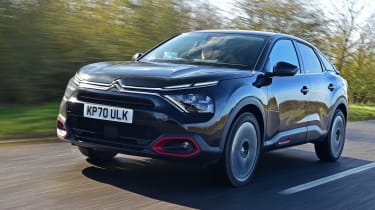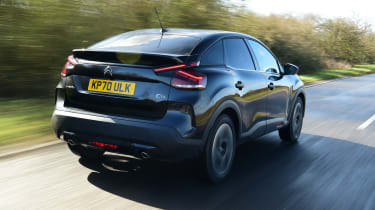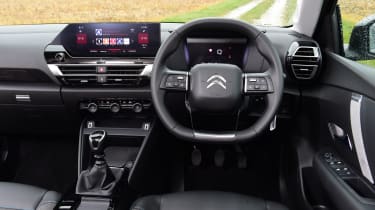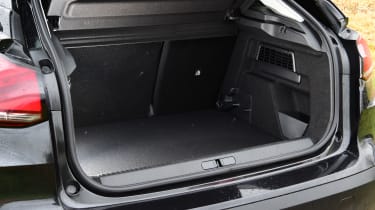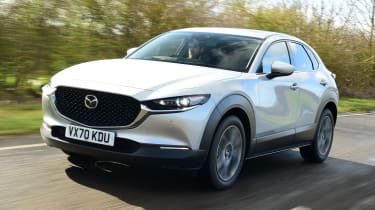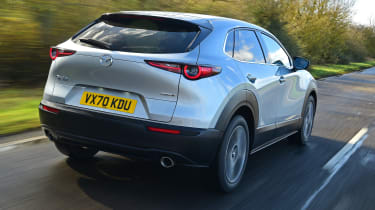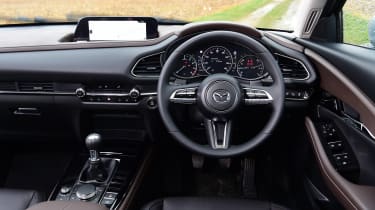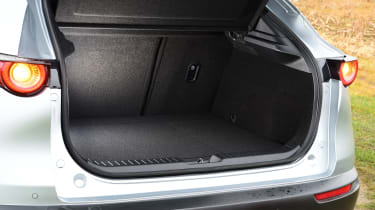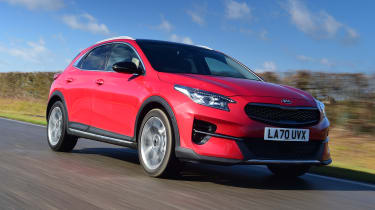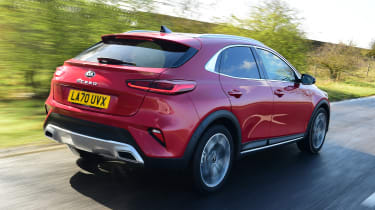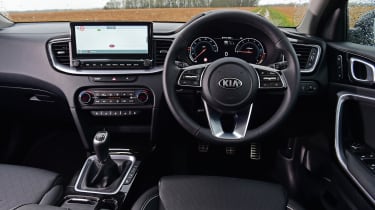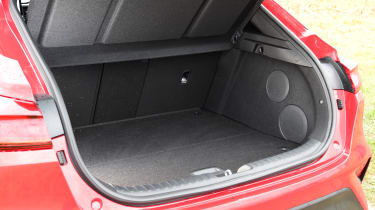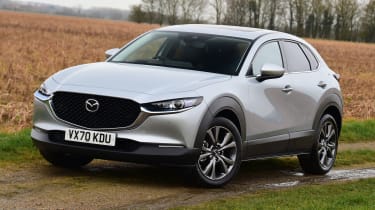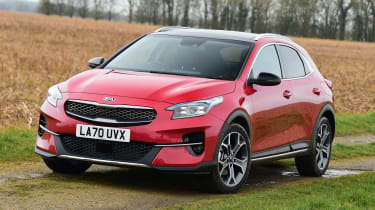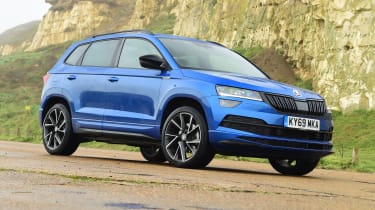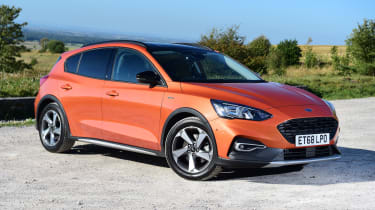We pitch the new Citroen C4, Mazda CX-30 and Kia XCeed against each other in a crossover clash
What exactly is the Citroen C4? It’s a question that’s hard to answer, partly because of its new design that’s somewhere between a normal hatchback and an SUV, and partly because the C4 name has been used on a number of cars over the past decade or so. It started out as a normal family hatch, like a Volkswagen Golf or a Ford Focus, but then the funky-looking and excellent C4 Cactus was introduced before the C4 hatch was dropped.
Then the C4 Cactus was toned down and made to look more like a hatchback thanks to a mid-life facelift, which we felt reduced its appeal. Now the C4 name is back, the Cactus branding has gone and the car has been restyled to have a bolder look that straddles the line between SUV and hatchback.
Cupra Formentor vs Alfa Romeo Stelvio vs Porsche Macan
We’ve brought it together with some other models that sit somewhere in that market position. First is the Kia XCeed, which is also new in this test, featuring a 1.5-litre petrol engine. Then there’s the Mazda CX-30, which has styling that brings it into SUV territory. It’s here to show what’s available if you have a slightly larger budget, because it’s a bit more expensive than the Citroen and Kia.
Citroen C4
| Model: | Citroen C4 PureTech 130 S&S Sense Plus |
| Price: | £23,005 |
| Engine: | 1.2-litre 3cyl turbo, 128bhp |
| 0-62mph: | 8.9 seconds |
| Test economy: | 37.4mpg/8.2mpl |
| CO2: | 120g/km |
| Annual road tax: | £150 |
The Citroen C4 we’re testing here is an entry-level Sense Plus model fitted with the PureTech 130 engine, which costs from £23,005. Our test car had options including some extra safety equipment that brought the total up to £24,800.
Design & engineering
While the Citroen C4 uses some familiar ingredients from the previous C4 Cactus, this is a new model with styling that reflects the direction that the brand wants to go with its cars in the future. The sharper angles on the bodywork are a step away from the softer, more rounded models that came before, for example.
The C4 also has a sister model, the e-C4, that uses electric power only, but it’s the petrol model we’re interested in here. This version has a 1.2-litre three-cylinder motor that produces 128bhp, which has been seen for many years in various Citroen cars in one form or another. It’s less powerful than the engines in these competitors, but the punchy performance means it doesn’t feel lacking.
Its most notable feature in terms of chassis technology is its hydraulic bump-stops. The front suspension has double stops and the rear has single stops. This set-up is designed to cushion bumps that send the suspension right to the bottom of its travel, so you don’t get a sharp jolt in the cabin. As we’ll discuss in ‘Driving’ (below), this system works well.
Another interesting point about the Citroen’s engineering is that it’s lighter than its rivals here by more than 160kg, which again helps with ride quality, a key focus for the brand’s engineers.
Value for money was another focus for the C4. Even this entry-level Sense Plus model comes with LED headlights, 18-inch alloy wheels, a 10-inch touchscreen infotainment system, dual-zone climate control, a head-up display and a reversing camera.
Interior quality is fine, but not near the Mazda CX-30’s high standard, and we’re pleased to see the air-con controls are no longer hidden in a touchscreen menu; they’re real buttons that are easy to use.
Driving
It’s clear that the focus on comfort has paid off in the Citroen C4, because it rides smoothly. Big bumps and potholes in the road don’t upset the car’s balance, nor do they thud into the cabin harshly, which is particularly useful if you drive in town a lot.
The ride isn’t as well controlled as the Mazda’s over roads that have lots of smaller bumps and imperfections, because you get a lot more body roll in corners, but there’s a similar level of comfort. All three cars in this test are really comfortable overall, but in a scale that went from softest to firmest, the Citroen would be first and the Mazda last.
While the Citroen isn’t very sporty as a result of the body roll in corners, it’s not dreadful in that respect. The least appealing aspect of the C4 from a driver’s point of view is the extremely light steering that has virtually no feel or feedback. This makes the new model easier to park, but it’s just not very interesting or engaging to drive.
The numb gearshift also lets it down, because its rivals have slick and enjoyable manual shifts. At least the Citroen’s engine is fun; it has a punchy feel from low revs that makes it feel more powerful than it is (it’s the least powerful here by quite a margin). It produces 128bhp, while the Kia has 158bhp and the Mazda 183bhp. But the C4’s 0-62mph time of 8.9 seconds is only slightly behind the XCeed’s 8.7-second 0-60mph time, for example.
Practicality
Often, Citroens are more practical than equivalent cars from other brands, but that isn’t the case with the latest C4. Its 380-litre boot puts it behind the Kia and Mazda, which have 426 and 430 litres respectively. These figures don’t tell the whole story, though, because when we had all three together, the difference in size didn’t look massive, so it’s unlikely to make a huge difference to most buyers.
The Citroen is also more roomy in the back for passengers than the CX-30, which has a rather cramped rear. The XCeed is the most spacious model for back-seat passengers, but the C4 does have room for adults to sit in the two outer seats with a decent amount of leg and headroom.
Interior storage is good in the French model, too, with big door bins, some other cubbies and even a clever tablet holder (costing an extra £100) for the front passenger to set up in front of them on the dash, which folds away when it’s not in use.
Ownership
Standard safety kit is a C4 strong point, especially as it’s the cheapest car here. It has autonomous emergency braking (AEB), lane-keep assist, attention alert, blind-spot detection, braking assistance in a crash and a reversing camera as standard even in entry-level form.
Ownership might not be as good as with the other models here, though; Citroen came in 18th out of 30 brands in our Driver Power 2020 survey, yet Kia finished second and Mazda fourth. That hints that owners of previous Citroens aren’t hugely happy with the firm, but because the C4 is so new we can’t make a definitive statements about its reliability.
Running costs
Citroen’s 1.2-litre engine is the smallest in capacity here, but wasn’t the most efficient, returning 37.4mpg, which works out at about £1,823 a year on average for fuel costs. It was a little better than the Kia’s 36.4mpg figure but the Mazda’s 41.9mpg was the best overall.
Yet the Citroen is the cheapest to buy and sits in the lowest company car tax band, at 27 per cent. The Kia is in the 31 per cent bracket and the Mazda the 29 per cent category, so it will cost standard-rate taxpayers £1,230 for the Citroen, £1,505 for the Kia and £1,510 for the Mazda in the 2020/21 tax year.
Testers’ notes
“The Citroen’s engine is punchy at low revs, but feels strained and wheezy the more you rev it. It suits the C4’s relaxed driving experience, however.”
Mazda CX-30
| Model: | Mazda CX-30 2.0 e-Skyactiv-X 186PS 2WD SE-L Lux |
| Price: | £26,300 |
| Engine: | 2.0-litre 4cyl, 183bhp |
| 0-62mph: | 8.3 seconds |
| Test economy: | 41.9mpg/9.2mpl |
| CO2: | 127g/km |
| Annual road tax: | £150 |
The Mazda CX-30 is the most expensive car here, but like its rivals, it’s somewhere between a normal hatch and a full-on SUV. It shows what you get by spending a little more, and comes with a hi-tech engine with mild-hybrid parts and lots of standard kit. In SE-L Lux trim, it costs £26,300.
Design & engineering
The Mazda CX-30 is based on the same platform as the Mazda 3, just like the XCeed uses the same tech as Kia’s Ceed hatch. It has a similar visual formula, too, with chunkier wheelarches and more ground clearance to give the CX-30 an SUV-like look without some of the drawbacks, such as excess weight and a high centre of gravity.
Engineering is a strong point for the CX-30, because it features a very clever powertrain. The Skyactiv-X engine uses something called ‘Spark Controlled Compression Ignition’, which is designed to make it run more like a diesel when you want economy, but more like a petrol when you’re seeking extra performance. It’s a complex system, but here’s how it works in a nutshell: its high compression ratio allows for a leaner fuel-air mixture, and a small spark is used to ignite a tiny amount of fuel, which then increases heat and pressure to combust the rest of the fuel. It switches seamlessly from this compression mode to normal spark ignition, and there’s also a mild-hybrid system, which recuperates energy under braking using a starter-generator and adds a small boost when pulling away from a standstill.
The Mazda’s interesting and unique engineering is part of why it’s more expensive than its rivals, but the interior is another reason. It’s by far the most upmarket when you get inside, with high-quality materials that even outdo some German models. Build quality is top-notch, so despite being the most expensive car here the Mazda still looks like good value.
Driving
Mazda is known for its brilliant MX-5 sports car, and you can feel the family connection even in the CX-30. The most obvious part is the gearchange, which is close to perfect, thanks to its position in the cabin and the ultra-slick action.
The Mazda is also the most fun to drive of this trio, since it’s composed and grippy in corners. It has the firmest suspension, but it’s not uncomfortable and smooths out bumps very well. In corners it rolls the least, which gives you confidence on a country road, plus it’s enjoyable and satisfying to drive.
Performance is good, because the Mazda’s 2.0-litre engine has the most power of the three cars, yet it doesn’t feel as fast as the Kia on most roads. That’s because to access the Mazda’s power you have to rev it hard, yet the ultra-long gear ratios – which are good for economy – mean that this isn’t a hugely enjoyable process. It’s a shame, because the driving experience is good, as is performance if you do use the revs; the 0-62mph sprint takes 8.3 seconds.
The Skyactiv-X engine doesn’t have a turbocharger, unlike both rivals. This is good and bad, because it’s smoother and power comes in gradually, rather than all at once like in the Citroen’s small 1.2-litre three-cylinder engine. It’s more satisfying for keen drivers, but for most people we reckon the turbo engines in its rivals will be easier to use and feel faster more of the time.
Fuel economy was good, though, and the engine is quiet in the cabin. There’s a slight diesel-like clatter at idle, where the engine runs on its high-compression ignition, but thanks to the mild-hybrid set-up, the stop-start system is pretty seamless and it’s generally very quiet inside the Mazda. Wind and road noise is lower than in either of its rivals on the motorway as well.
Practicality
The CX-30’s 430-litre boot is the biggest here, but it’s worth noting that more conventional SUVs, such as the Skoda Karoq, have much more luggage room. The Mazda is also the most cramped when it comes to passenger space.
There’s enough legroom for adults in the back, and once you’re settled there’s just about enough headroom. But it feels dark inside, thanks to the small windows, and on our test car the sunroof meant that we bumped our heads getting in and out of the back seats. The SE-L Lux model doesn’t have a sunroof, though, so it shouldn’t be an issue on lower-spec cars. Higher trim levels also have an upgraded stereo that takes up some boot space, so are less practical despite their generous amount of kit.
Ownership
Our Driver Power 2020 survey revealed that Mazdas should offer a very good ownership experience. The brand placed fourth overall, just two places behind Kia, but still in the top five. Both were well ahead of Citroen in 18th, although Mazda’s dealerships (12th) dropped behind the French brand (eighth) in that section of the poll, while Kia’s franchises came seventh
The CX-30 scored a five-star Euro NCAP rating, and even more impressive was its 99 per cent result in the Adult Protection category. It features blind-spot assist, lane-keeping, parking sensors all round and
a reversing camera, so it’s the safest model here.
Running costs
Mazda’s clever engine and mild- hybrid set-up should have delivered diesel-like running costs if the marketing was to be believed, but in the real world it was only a little ahead of the Citroen and Kia here. Nevertheless, it was the most efficient model in our test, so we have to commend it for achieving 41.9mpg.
The CX-30 is well equipped, but its higher asking price than its rivals here means it doesn’t have as much appeal for cash buyers. Yet on finance, it looks very good value (see Through the Range, right) and is actually cheaper than the C4 and XCeed per month.
Testers’ notes
“Like all mild-hybrid systems, you can hardly feel it working in the CX-30; it’s not like using a full-hybrid because the engine always drives the wheels.”
Kia XCeed
| Model: | Kia XCeed 1.5 T-GDi 158bhp ISG 3 |
| Price: | 24,550 |
| Engine: | 1.5-litre 4cyl turbo, 158bhp |
| 0-60mph: | 8.7 seconds (0-62mph figure not available) |
| Test economy: | 36.4mpg/8.0mpl |
| CO2: | 142g/km |
| Annual road tax: | £150 |
The Kia XCeed is closely related to the Ceed hatchback, yet its more SUV-like looks mean it has a different kind of appeal. The car we’re testing here is the new 1.5-litre petrol model, which we’ve not tried before. Although our pictures show a variant in 4 trim, the XCeed we’re testing is the lower-spec 3 version, which costs £24,550.
Design & engineering
The Kia XCeed is a bit like the C4 in the sense that it’s tough to place it in a traditional market segment. Kia already has SUVs in the main categories, plus the normal Ceed in the family hatchback class. Yet the XCeed is a different model, bringing elements of both types of car.
It uses the same platform as a normal Ceed, but has 44mm higher ground clearance, as well as a longer and wider body. While the XCeed may share its architecture with the hatchback, there’s no doubt that the various styling tweaks, such as the rugged-looking wheelarch covers, give it a different look to the standard Ceed.
The XCeed also has hydraulic bump stops, just like on the Citroen C4, which is great for ride comfort. The suspension set-up is a MacPherson-strut front and multi-link rear axle, which is a complex system that helps to deliver that smooth ride.
Our test car uses a 1.5-litre petrol engine, which is new and replaces the previous 1.4-litre petrol motor. With 158bhp, it’s not quite as powerful as the Mazda’s 183bhp, but the turbocharger means it has more torque than either of its rivals, at 253Nm. That figure comes in at just 1,500rpm, which is nice and low in the rev range; the Mazda’s maximum torque of 240Nm comes in from 4,000rpm.
In the cabin, quality is good and you get a fantastic 10.25-inch infotainment system that has everything you need, including Android Auto and Apple CarPlay. Equipment is a strong point, in fact, because even this lowly 3 model gets climate and cruise control, heated seats, sat-nav, keyless go and LED lights.
Driving
The XCeed sits in between the Citroen and the Mazda when it comes to the firmness of the ride on the road, but that doesn’t necessarily mean that the Citroen is the most comfortable and the Mazda is the least. They’re actually pretty evenly matched, because while the C4 pitches into corners and the CX-30 feels well controlled, the Kia sits somewhere in between. They’re all valid, and successful, approaches to creating a comfortable car.
Despite the steering having very little feel or feedback, the Kia is good to drive, because it has lots of grip and feels well controlled in bends.
The six-speed manual gearbox is good to use as well, with a slick action that’s much better than the rubbery-feeling shift in the Citroen. Neither is as good as the Mazda in this department, though.
Kia’s new 1.5-litre petrol engine is impressive in the most important areas, too. It’s quiet, especially on the motorway and at idle, plus it has punchy power delivery with lots of torque from low revs. Performance is decent; 0-60mph takes 8.7 seconds, which is plenty for a family car like this. It’s enough to enjoy swift progress on a twisty road, which you can’t really say of most of Kia’s SUVs, so we’re starting to see why the XCeed makes sense.
However, the new engine does have a couple of drawbacks. It feels lethargic below 1500rpm, so you need to give it more revs than expected to pull away smoothly, or change down to overtake in some situations. The engine also sounds strained if you use all the revs, so it’s best to keep it relaxed.
Still, the driving position is good, because there’s plenty of adjustment and you can get the seat nice and low, something you often can’t do in SUVs.
Practicality
With 426 litres of space available in the boot of the XCeed, it’s a practical family car. It’s not far off matching the Mazda CX-30’s 430 litres, and both beat the C4’s 380-litre space. Fold down the rear seats and there’s 1,378 litres, which sits in between the Mazda and Citroen’s 1,406 litres and 1,250 litres respectively.
There’s plenty of room in the cabin, with enough head and legroom for adults to get comfortable and lots of storage in the big door bins and central cubby.
Unfortunately if you’re planning to tow, the XCeed falls behind its test rivals. It has a maximum capacity of 1,000kg, which trails the C4’s 1,200kg and the CX-30’s 1,300kg ratings.
Ownership
The level of safety kit available is strong and matches its rivals. The XCeed has AEB, lane-keep assist, parking sensors and a reversing camera as standard.
Euro NCAP rated the Kia Ceed, and by extension the XCeed, at five out of five stars, so it’s certified as a safe family car choice.
Kia’s excellent seven-year warranty shows how confident the brand is about reliability, and our Driver Power survey reflects this. Owners placed Kia second overall out of 30 makers in 2020, which means it should offer a great ownership experience.
Running costs
The new 1.5-litre petrol engine impressed from behind the wheel, but we were disappointed to find that it only returned 36.4mpg during our test. That put it behind the C4’s 37.4mpg and the CX-30’s 41.9mpg fuel economy figures.
Our experts predict that the Kia will be worth £9,650 (39 per cent of its new value) after three years or 36,000 miles, which puts it well behind the Citroen C4. That model will be worth £11,549 after the same amount of time, which is 50.2 per cent per cent of its new value. The Mazda retains 53.2 per cent, which works out at a value of £13,992.
Testers’ notes
“The Kia sits in a higher company car tax bracket than its rivals here, and when the competition is this tight, that could be a deciding factor for many people.”
Verdict
First place: Mazda CX-30
The Mazda CX-30 is the most expensive model here, but on finance – how the vast majority of buyers will pay for their car – the Mazda is actually the cheapest. The fact that it’s also the most engaging to drive, has the biggest boot and the most efficient engine means it grabs a win here. It’s a little cramped in the rear, but overall it’s a high-quality car that’s great value at the moment.
Second place: Kia XCeed
If you need rear-seat space then the Kia XCeed is the best choice here, because it’s roomy and comfortable. It’s also good to drive and has a punchy, quiet engine, plus an impressive seven-year warranty. Yet we found the motor wasn’t very economical and the Kia is a little expensive on finance, so it finishes second here. It’s a close result, though.
Third place: Citroen C4
The Citroen may finish third, but it doesn’t lag behind its rivals by much. It’s comfortable and well equipped, and the low list price means it’s good value and the cheapest for company car drivers. It’s roomy enough for most people and the engine is punchy, but it’s let down by a disappointing fuel economy, a dull driving experience and a smaller boot than its rivals.
Also consider…
Skoda Karoq
- Model: Skoda Karoq 1.0 TSI SE L
- Price: £25,810
- Engine: 1.0-litre 3cyl, 108bhp
Skoda’s Karoq is a mid-size SUV, and you don’t get as much for your money here in powertrain terms; our budget only allows a smaller 1.0-litre model. Yet this engine is good and the Karoq is more practical than any of our rivals above. It’s also well equipped.
Ford Focus
- Model: Ford Focus Active 1.0 EcoBoost Active Edition
- Price: £24,755
- Engine: 1.0-litre 3cyl, 153bhp
The Focus Active is a lot like the XCeed, since it’s a raised and restyled version of the regular Ford Focus. It’s great to drive, and features a powerful 153bhp version of Ford’s 1.0-litre engine. It’s available as an estate for even more practicality, too.
Figures
| Mazda CX-30 2.0 e-Skyactiv-X 186PS 2WD SE-L Lux | Kia XCeed 1.5 T-GDi 158bhp ISG ‘3’ | Citroen C4 PureTech 130 S&S Sense Plus | |
| On the road price/total as tested | £26,300/£26,300 | £24,550/£24,550 | £23,005/£24,800 |
| Residual value (after 3yrs/36,000) | £13,992/53.2% | £9,650/39.3% | £11,549/50.2% |
| Depreciation | £12,308 | £14,902 | £11,456 |
| Annual tax liability std/higher rate | £1,510/£3,019 | £1,505/£3,011 | £1,230/£2,460 |
| Annual fuel cost (12k/20k miles) | £1,627/£2,712 | £1,873/£3,122 | £1,823/£3,039 |
| Insurance group/quote/VED | 18/£503/£150 | 19/£460/£150 | TBC/£610/£150 |
| Cost of 1st/2nd/3rd service | £799 (3 years) | N/A | N/A |
| Length/wheelbase | 4,395/2,655mm | 4,395/2,650mm | 4,360/2,670mm |
| Height/width | 1,540/1,795mm | 1,495/1,826mm | 1,525/1,800mm |
| Engine | 4cyl in-line/1,998cc | 4cyl in-line/1,482cc | 3cyl in-line/1,199cc |
| Peak power/revs | 183/6,000 bhp/rpm | 158/6,000 bhp/rpm | 128/5,500 bhp/rpm |
| Peak torque/revs | 240/4,000 Nm/rpm | 253/1,500 Nm/rpm | 230/1,750 Nm/rpm |
| Transmission | 6-speed man/fwd | 6-speed man/fwd | 6-speed man/fwd |
| Fuel tank capacity/spare wheel | 51 litres/repair kit | 50 litres/repair kit | 50 litres/repair kit |
| Boot capacity (seats up/down) | 430/1,406 litres | 426/1,378 litres | 380/1,250 litres |
| Kerbweight/payload/towing weight | 1,431/534/1,300kg | 1,416/424/1,000kg | 1,247/488/1,200kg |
| Turning circle | 10.6 metres | 10.6 metres | 10.9 metres |
| Basic warranty (miles)/recovery | 3yrs (60,000 miles)/3yrs | 7yrs (100,000)/1yr | 3 yrs (60,000)/1yr |
| NCAP: Adult/child/ped./assist/stars | 4th/12th | 2nd/7th | 18th/8th |
| Driver Power manufacturer/dealer pos. | 99/86/80/77/5 | 88/85/68/73/5 | N/A |
| 0-62mph/top speed | 8.3 secs/127mph | 8.7 secs*/129mph | 8.9 secs/130mph |
| Auto Express econ. (mpg/mpl)/range | 41.9/9.2/470 miles | 36.4/8.0/400 miles | 37.4/8.2/411 miles |
| WLTP combined | 50.4mpg | 42.8mpg | 47.3-54.7mpg |
| WLTP combined | 11.1mpl | 9.4mpl | 10.4-12.0mpl |
| Actual/claimed CO2/tax bracket | 156/127g/km/29% | 179/142g/km/31% | 174/120g/km/27% |
| Airbags/Isofix/parking sensors/cam. | Seven/yes/F&R/yes | Six/yes/R/yes | Six/yes/R/yes |
| Auto box/lane-keep/blindspot/AEB | £1,540/yes/yes/yes | £1,100/yes/no/yes | £1,400/yes/yes/yes |
| Clim./cruise ctrl/leather/heated seats | Yes/yes/no/yes | Yes/yes/artificial/yes | Yes/yes/no/no |
| Met paint/LEDs/keyless/pwr tailgate | £570/yes/yes/no | £580/yes/yes/no | £545/yes/£300/no |
| Nav/digi dash/DAB/connected services | Yes/no/yes/yes | Yes/no/yes/yes | Yes/yes/yes/yes |
| Wireless charge/CarPlay/Android Auto | No/yes/yes | No/yes/yes | No/yes/yes |
Source: Read Full Article
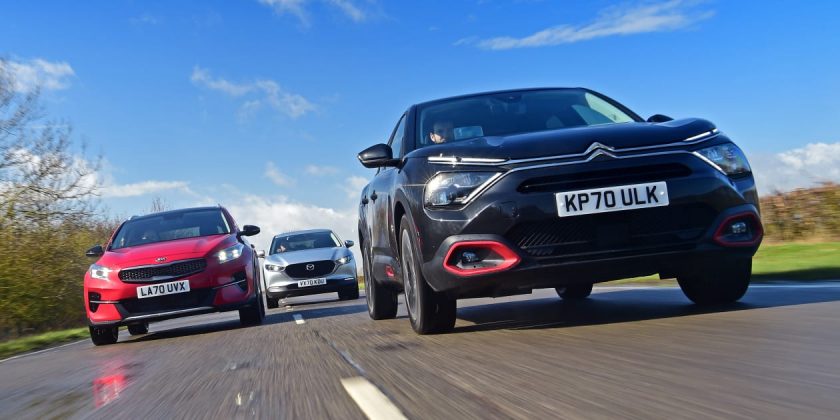
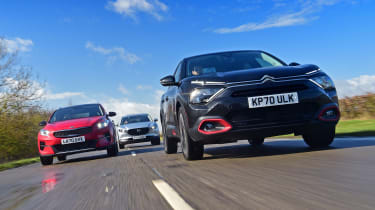
 Cupra Formentor vs Alfa Romeo Stelvio vs Porsche Macan
Cupra Formentor vs Alfa Romeo Stelvio vs Porsche Macan